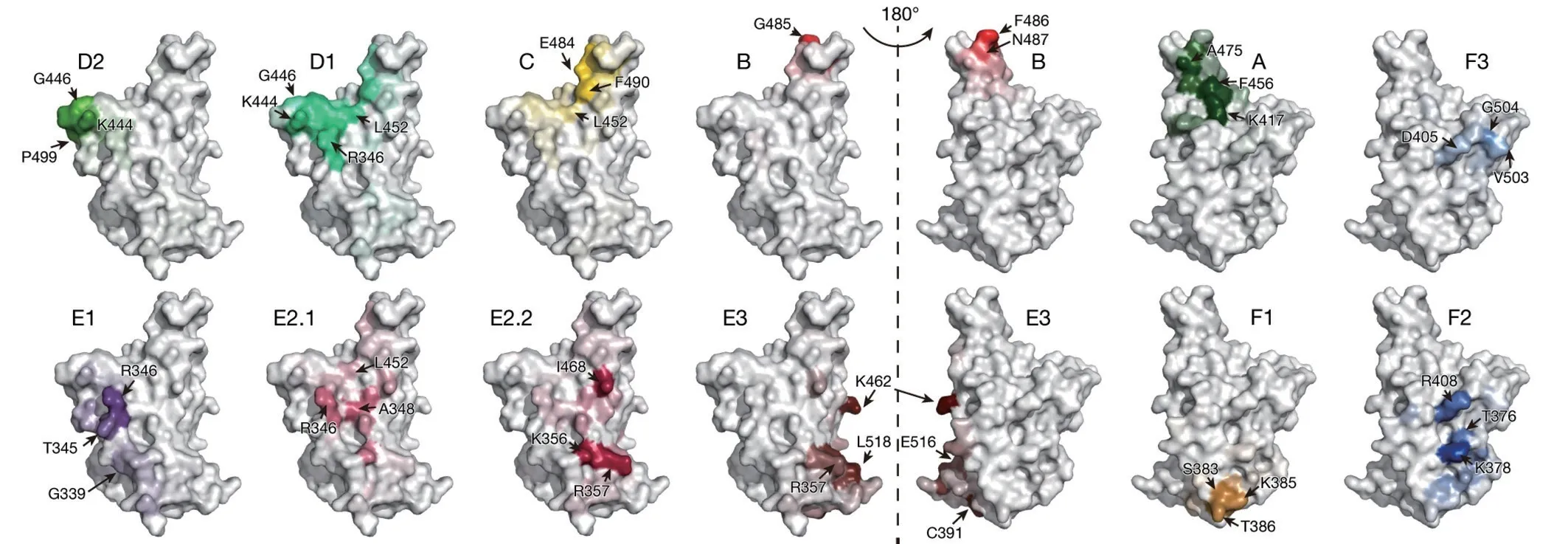China’s Top 10 Science Advances in 2022
2023-09-09BySONGJianlanandYANFushengStaffReporters
By SONG Jianlan and YAN Fusheng (Staff Reporters)
China’s Mars exploration, again, outstood others in the list of the country’s Annual Top 10 Science Advances for 2022.As announced by the High Technology Research and Development Center (HTRDC) of the Chinese Ministry of Science and Technology on March 17, 2023,Zhurong, the Mars rover of China, topped the list with its revelation of the refined layered structure of theUtopia Planitiasubsurface strata via itsin situexploration.
On the list are other scintillating feats, for example the successful characterization of repeating fast radio bursts(FRBs), and the discovery of SARS-CoV-2 Omicron variants’mutation traits and immune evasion mechanisms.Six out of the ten are achieved by scientists from the Chinese Academy of Sciences (CAS) as leading researchers or significant participants.
This marks the 18thelection and release of the Annual Top 10 advances, an effort made by the ministry and five academic journals to promote scientific advancement and increase public awareness of science.Results published between December 1, 2021 and November 30 of 2022 are eligible for nomination and competition.
Now, let’s embark on the journey to recall the bright stars of 2022.

Zhurong (left), the Chinese Mars rover named after the God of Fire from Chinese mythology, poses together with the lander on the Red Planet.One week after its successful soft landing in May 2021, the lander of Tianwen-1 released the 240-kg rover to conduct in situ investigations across the Martian terrains.(Image: CNSA/MARS)
1st Successful Revelation of Layered Subsurface of the Utopia Plantitia by Zhurong
Zhurong, the 240 kg Mars rover named after the God of Fire from Chinese mythology, was released on theUtopia Planitiasurface in May 2021 to conductin situinvestigations across the dusty, rugged Martian terrains.In the ensuing four months, the rover covered a journey of 1,171 meters, and obtained massive data using the low-frequency radar onboard.
Detailed subsurface structure and material composition of Mars are the key to understanding the geology as well as the habitability evolution of the planet, and have been made an important science objective of the Mars mission.Based on the analysis of these data,a joint team led by Profs.CHEN Ling and ZHANG Jinhai from the CAS Institute of Geology and Geophysics (IGG) obtained high-accuracy structured layered images of the subsurface strata(within 80 m beneath the surface) of southernUtopia Planitia, and extracted information about the material composition.
Their research revealed that beneath the Martian soil of this area,there exist two sets of sedimentary sequences.The first, spreading at a depth ranging from 10 to 30 meters, could be the residual from the brief floods, long-term weathering or repeated meteorite impacts since 1.6 billion years ago; and the second, lying at a depth of 30 to 80 meters beneath the surface, might be the sediment left behind by a deluge from 3.5 to 3.2 billion years ago.Their research did not find any evidence of liquid water, but did not rule out the existence of eutectic ice, either.
The research provides observational evidence of water activity, laying a foundation for further understanding the geological evolution and environment as well as climate changes of the planet.

A team from the CAS Institute of Geology and Geophysics (IGG) first reveals the refined layered structure of the Utopia Plantitia subsurface strata,based on the data obtained by Zhurong, China’s first Mars rover in its four-month-long in situ investigation covering a journey of 1,171 m.(Image by DENG J.Credit: IGG)

The image and interpretation based on data obtained by the low-frequency radar onboard Zhurong along a trail when the rover trekked down the Utopia Plantitia surface from the south to the north.(Image credit: IGG)
2nd Characterization of Active Repeating Fast Radio Bursts by FAST
Fast radio bursts (FRBs) represent the most violent explosive phenomenon in the radio universe, and their origin has been a hot target of astronomical exploration.With the aid of the Five-hundred-meter Aperture Spherical radio Telescope (FAST), a team led by Prof.LI Di from the National Astronomical Observatories, CAS (NAOC) detected the first known active fast radio burst (labeled FRB190520B), which boasts an environmental electron density much larger than any other sources.This continuously active FRB has since greatly promoted the multiband observations and research on FRBs,and its discovery marks a milestone in the characterization of repeating FRBs.
The team also monitored another actively repeating source FRB20201124A to obtain a dataset of FRB polarization measurements that remains the biggest sample observed so far.Further, they detected variations in magnetic field strength in the local environments, and discovered the frequencydependent polarization oscillation: a trend of lower polarization at lower frequencies.
Targeting this kind of actively repeating FRBs, the team conducted coordinated observations using FAST and the Robert C.Byrd Green Bank Telescope located in the USA, and established a model to characterize the behavior of FRB polarization with a single parameter, namely the rotation measure (RM) scattering.They found that sources with higher values of RM scattering have higher RM magnitudes and scattering time scales, and the two sources with the highest RM scatter are associated with compact persistent radio sources.The team proposed a unified mechanism for the frequency evolution of FRB polarization.
Such a unified description of repeating FRBs indicates a complex environment near and/or around the bursting sources, which could be a supernova remnant, a pulsar wind nebula, or plasma near massive blackholes.
The above-mentioned work advances the characterization of repeating FRBs and their environments, thus laying a foundation for the search of their origin.

Images: CAS
3rd Splitting Seawater into Hydrogen Fuel Using New Mechanism
On November 30, 2022, a research team led by CAS Member XIE Heping at Shenzhen University and Sichuan University demonstrated a novel membrane-based seawater electrolysis method for hydrogen production.Published inNature, this research presents a breakthrough in efficiently and directly electrolyzing seawater without desalination and side reactions.

A membrane-based seawater electrolysis method for hydrogen production (Image by XIE Heping’s group)
Traditional electrolysis systems face challenges due to impurities in seawater, which can cause side reactions and corrosion, thereby reducing electrode durability.Although desalination prior to electrolysis has been considered, the additional energy and space requirements make it less appealing.
XIE’s team has devised a new theoretical model that combines physical mechanics and electrochemistry, with the potential to revolutionize the field.
In this novel system, two electrode layers are separated by a diaphragm layer and immersed in a self-dampening electrolyte (SDE) of concentrated potassium hydroxide solution.A membrane separates the SDE from seawater,allowing only water vapor to pass through into the SDE.The pressure difference between the seawater and SDE initiates spontaneous evaporation, with vapor diffusing across the membrane and reverting to liquid in the SDE.Electrolysis-driven water consumption within the SDE maintains the pressure difference, ensuring a continuous supply of fresh water.
The highly stable, waterproof, and breathable membrane is well-suited for long-term operation in complex environments.The team built the world’s first 386 L/h direct seawater electrolysis system for hydrogen production,which has operated continuously for over 3,200 hours in Shenzhen Bay.
This innovative technology holds the potential to integrate renewable energy sources, such as offshore wind power,with seawater electrolysis for hydrogen production, converting the abundant resource of seawater into a sustainable energy source.
4th The Mutation Traits and Immune Evasion Mechanisms of Omicron Variants
The continuous emergence of the SARS-CoV-2 Omicron variant and its sub-lineages highlighted the importance of timely analysis of how these variants evade the immune barriers established by vaccination and the immunity generated by virus infection.Such analysis is essential for future vaccine design and effective epidemic prevention and control.
The joint team of Dr.CAO Yunlong and Dr.XIE Xiaoliang from Peking University and Beijing Changping Laboratory, together with Dr.WANG Xiangxi’s team from the CAS Institute of Biophysics, has taken the lead in revealing the humoral immune evasion mechanism and mutation evolution characteristics of the SARS-CoV-2 Omicron variant and its new sub-lineages.
Published inNatureon June 17, 2022, the results show that Omicron sublineages BA.2.12.1, BA.4, and BA.5 have higher transmissibility and immune-evasion capabilities than the BA.2.Though the binding affinities of these variants to the angiotensin-converting enzyme 2 (ACE2) receptor were similar to that of the BA.2 lineage, BA.2.12.1 and BA.4/BA.5 sublineages exhibited increased evasion of neutralizing antibodies, particularly against plasma from triple-vaccinated individuals or those who had developed a BA.1 infection after vaccination.This finding indicates that achieving herd immunity to halt the spread of COVID-19 through BA.1 infection is unattainable.
Using the self-developed high-throughput mutation scanning technology, the researchers successfully predicted the immune evasion mutation sites in the receptor-binding domain and proactively screened for broad-spectrum neutralizing antibodies.This study offers design principles for developing wide-ranging COVID-19 vaccines and antibody therapies and valuable insights for global COVID-19 prevention and control strategies.

5th Breakthrough in All-Perovskite Tandem Solar Cells
Jointly led by Dr.TAN Hairen from Nanjing University and Dr.Edward H.Sargent from the University of Toronto, a team of scientists has made a significant progress in developing metal-halide perovskite-based tandem solar cells.This advancement may bring us closer to a new era of affordable, high-efficiency solar energy solutions.
The study, entitled “All-perovskite tandem solar cells with improved grain surface passivation,”was published inNatureon January 17, 2022.
Perovskites are photovoltaic (PV) materials with tunable bandgaps, making them ideal candidates for tandem solar cell applications.However, low photocurrent densities have restricted the power conversion efficiency(PCE) of all-perovskite tandem solar cells.Researchers have thus sought to improve carrier diffusion length in lead-tin (Pb-Sn) perovskite films.
Grain surface passivation, a technique that reduces trap density at the surface and grain boundaries of the film,shows promise for increasing carrier diffusion length.Previously, grain-surface-passivated Pb-Sn perovskite films were limited to thicknesses under 1 micrometer, thus insufficient for achieving higher matched photocurrent densities in allperovskite tandem solar cells.
TAN and his colleagues have now devised a method to enhance the adsorption of passivating agents during perovskite film formation, allowing for more comprehensive coverage of defective sites on grain surfaces.This innovation is expected to increase the diffusion length in thicker Pb-Sn perovskite films, facilitating the use of thicker absorber layers and higher photocurrent densities in all-perovskite tandem solar cells.
Independently tested by the Japan Electrical Safety & Environment Technology Laboratories (JET), the tandem solar cell achieved a record-breaking 26.4% efficiency for perovskite solar cells, surpassing single-junction perovskite solar cells for the first time.This efficiency matches the highest efficiency of mainstream silicon solar cells on the market.
The researchers developed a scalable manufacturing technology for large-area tandem photovoltaic modules,employing a dense semiconductor barrier layer to prevent contact between the perovskite and metal back electrode in the interconnected module area.This innovation significantly improved the photovoltaic performance and stability of the modules, resulting in a tandem module with an internationally certified efficiency of 21.7% (with an area of 20 cm2).
The demonstration of charging a cell phone with an all-perovskite tandem solar cell.(Image by TAN Hairen’s group)
Significantly, the researchers utilized molecular dynamic simulations to guide their experimental design and advance the rational molecular design of passivators.This groundbreaking approach may spur further progress in perovskite solar cells and contribute to a more sustainable, cost-effective energy future.

The demonstration of charging a cell phone with an all-perovskite tandem solar cell.(Image by TAN Hairen’s group)
6th Single-Element Tellurium Switch Promises Denser Memory Chips
In a study published inNatureon December 10, 2021, a research team led by Dr.SONG Zhitang and Dr.ZHU Min from the Shanghai Institute of Microsystem and Information Technology (SIMIT), CAS, constructed a pure tellurium device capable of rapid switching through phase transformation.

A schematic for the new single-element tellurium switch.(Image: CAS)
Phase-change materials hold promise for computer memory and switching applications due to their compact size and fast switching speeds.However, commonly used materials often contain multiple elements, which can reduce switching reliability.
The researchers made a significant breakthrough in nonvolatile phase-change memory development by creating a single-element tellurium (Te) volatile switch.This advancement could enable the production of denser memory chips,as scaling memory cells and their associated two-terminal access switches below 10 nanometers necessitates more homogeneous materials.
The novel single-element Te volatile switch exhibits remarkable characteristics, including a large drive current density (≥11 megaamperes per square centimeter), a ~103 ON/OFF current ratio, and a switching speed faster than 20 nanoseconds.The low OFF current stems from a ~0.95-electron volt Schottky barrier at the Te-electrode interface,while the high ON current results from a transient, voltage pulse-induced crystal-liquid melting transition of pure Te.
Featuring a simple composition, the switch overcomes component segregation issues associated with the complex components of Ovonic threshold switches (OTS).The device is compatible with CMOS technology and can be extensively miniaturized, facilitating massive three-dimensional integration.
This innovative single-element electrical switch could revolutionize the memory chip industry by enabling the development of denser memory chips, ultimately improving the performance and capacity of electronic devices.
“During the switching process, tellurium is melted and shows metallic property, providing a high drive current.When it is in solid state, the switch is off,”said Dr.ZHU Min, a corresponding author of the paper, in an interview.
A perspective published in the same issue ofSciencedescribed the accomplishment as unprecedented.
7th Quantum Coherent Synthesis of Ultracold Triatomic Molecules
Modeling complicated chemical reactions with highly controllable ultracold molecules, scientists can study a complex system accurately and comprehensively.Since Deborah Jin’s group at University of Colorado successfully synthesized diatomic potassium molecules in ultracold atomic gas in 2003, multiple types of ultracold diatomic molecules have been synthesized in other labs, and found their applications in ultracold chemistry and quantum simulation research.
Theoretically, it is difficult to calculate the energy-level structure of triatomic molecules;and it is also extremely difficult to manipulate them in experiments.Therefore, it has long been a big challenge to prepare ultracold triatomic molecules in labs.In cooperation with CAS Member BAI Chunli’s team from the CAS Institute of Chemistry, the joint team led by CAS Member PAN Jianwei and Prof.ZHAO Bo from University of Science and Technology of China successfully performed quantum coherent synthesis of ultra-cold triatomic molecules in a mixture of gaseous ground-state sodium/potassium molecules and potassium atoms, using a Feshbach resonance between them.This work has furthered the understanding of the complex ultracold atom-molecule Feshbach resonances and might offer new opportunities for research in ultra-cold chemistry and quantum simulation.

Synthesis of triatomic molecule in a mixture of ultracold diatomic molecules and atoms using a radio-frequency field.(Image: CAS)
8th Synthesis of Ethylene Glycol under Ambient Pressure
Scientists have developed a more efficient method for producing ethylene glycol (EG), a vital bulk chemical widely used across various industries.Conventionally,EG is synthesized from either ethylene or syngas, with the latter facing challenges due to a bottleneck reaction and the need for high hydrogen pressures.
As appeared in the April 14, 2022 issue ofScience,the research team of Dr.XIE Suyuan from Xiamen University, along with Dr.YUAN Youzhu’s team, jointly collaborated with researchers from the Fujian Institute of Research on the Structure of Matter, CAS and Xiamen Funano New Materials Technology demonstrated that fullerene (C60) can be used as an electron buffer for a copper-silica catalyst (Cu/SiO2) to improve this process.
When hydrogenating dimethyl oxalate (DMO),an intermediate that can be produced in an alreadyindustrialized ambient reaction from syngas, with the C60-Cu/SiO2catalyst at ambient pressure and temperatures between 180°C and 190°C, they achieved an impressive EG yield of up to 98 ± 1%.
In a kilogram-scale reaction, the catalyst displayed no signs of deactivation after 1,000 hours of use.This innovative and mild method for the final step towards EG synthesis can be integrated with the existing industrial process that converts syngas to intermediate dimethyl oxalate.This advancement can potentially make EG production more sustainable and efficient in the future.
Significantly, this breakthrough enabled the synthesis of ethylene glycol on a scale of thousands of kilograms under mild pressure conditions, reducing reliance on the petroleum technology route.
9th Direct 3D Lithography of Stable Perovskite Nanocrystals in Glass
When we direct ultrafast laser pulses at materials, a range of highly nonlinear effects emerge and cause complex and intriguing light-matter interactions under these extreme conditions, which are rich with undiscovered phenomena.
A team led by Dr.QIU Jianrong from Zhejiang University and their collaborators discovered a new mechanism that allows accurate control of such interactions using ultrafast laser pulses that caused local melting and subsequent crystallization.
In the study, they utilized three-dimensional (3D) direct lithography and ultrafast laser-induced liquid nanophase separation to control the halide ion distribution at the nanoscale.Using an oxide glass system containing chloride,bromide, and iodide ions as an example, they achieved 3D direct laser writing of perovskite nanocrystals (PNCs) with composition and bandgap tunable luminescence in glass, displaying various colors such as red, orange, yellow, green,and blue.The resultant PNCs display remarkable stability against ultraviolet (UV) irradiation, organic solutions, and high temperatures up to 250°C.

Direct lithography of colored PNCs and patterns in glass using ultrafast lasers.(Image by QIU Jianrong’s group)
Furthermore, they demonstrated the use of these 3D micro-nanostructures for ultra-high-capacity, long-life information storage, highly stable micron-scale Micro-LED arrays with minimum pixel size, and 1080p dynamic stereoscopic color holographic displays.This new technology overcomes the limits, such as introducing organic contamination and requiring multiple steps, which were found in traditional methods of material composition engineering and device fabrication for PNCs in solution.
The team also verified the proposed mechanisms behind the formation and composition tunability of the PNCs,marking a significant advancement in the field of material science and nanotechnology.
10th Experimental Verification of Segmented Fermi Surface in Superconductivity
The Fermi surface determines multiple physical properties of solid materials, including their electrical and optical properties.Therefore, artificial manipulation of the Fermi surface makes the most important approach to the regulation and control of materials properties.Due to the existence of energy gaps at the Fermi level, superconductors do not have Fermi surfaces.Peter Fulde, however, predicted in 1967 that increasing the momentum of the Cooper pairs in the superconductor can break them down,hence producing a special “segmented Fermi surface”in the superconductive energy gap.However,observing this segmented Fermi surface directly proved to be tricky.
A team from Shanghai Jiao Tong University led by Profs.JIA Jinfeng and ZHENG Hao succeeded in experimental verification of Fulde’s theoretical prediction, in cooperation with Dr.FU Liang’s team at Massachusetts Institute of Technology.They designed and prepared a thin film of the topological insulator bismuth telluride placed on top of superconducting niobium diselenide (Bi2Te3/NbSe2), and applied a small magnetic field to cause a screening current.The latter led to a segmented Fermi surface in the topological insulator layer.Using a scanning tunneling microscope,the researchers mapped out this Fermi surface.
This work provides a new approach to manipulating matter states and constructing new-type topological superconductors.

Superconductive sectional Fermi surface
